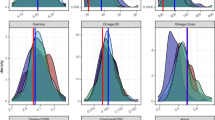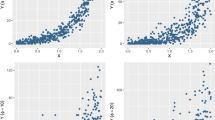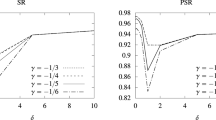Abstract
In 2006 there was quite some discussion on how to estimate the conditional estimation error in the chain-ladder (CL) model of Mack. Buchwalder, Bühlmann, Merz and Wüthrich (BBMW) (ASTIN Bull 36(2):521–542, 2006) proposed another estimator than the one derived by Mack (ASTIN Bull 23(2):213–225, 1993). These two estimators are also found in a broader context by new authors in recent papers. In the present paper we examine the theoretical properties of the two estimators and come to the conclusion that the BBMW estimator has some major deficiencies compared with the Mack estimator. It takes much less information of the observed triangle into account, the averaging is done over inappropriate sets and it does not properly fit to the Mack CL-model.
Similar content being viewed by others
References
Buchwalder M, Bühlmann H, Merz M, Wüthrich M (2006) The mean square error of prediction in the chain ladder reserving method (Mack and Murphy Revisited). ASTIN Bull 36(2):521–542
Buchwalder M, Bühlmann H, Merz M, Wüthrich M (2006) The mean square error of prediction in the chain Ladder reserving method-final remark. ASTIN Bull 36(2):553
Diers D, Linde M, Hahn L (2016) Quantification of multi-year non-life insurance risk in chain ladder reserving models. Insur Math Econ 67:187–199
Gisler A (2006) The estimation error in the chain-ladder reserving method: a Bayesian approach. ASTIN Bull 36(2):554–565
Gisler A (2016) The chain ladder reserve uncertainties revisited. Paper presented at the ASTIN colloquium 2016 in Lisbon
Gisler A (2019) The reserve uncertainties in the Chain-Ladder model of Mack revisited. ASTIN Bull 49(3):787–821
Lindholm M, Lindkog F, Wahl F (2020) Estimation of conditional mean squared error of prediction for claims reserving. Ann Actuar Sci 14(1):93–128
Merz M, Wüthrich MV (2014) Claims run-off uncertainty: the full picture. SSRN manuscript 2524352
Mack T (1993) Distribution-free calculation of the standard error of chain ladder reserve estimates. ASTIN Bull 23(2):213–225
Mack T, Quarg B, Braun C (2006) The mean square error of prediction in the Chain ladder reserving method—a Comment. ASTIN Bull 36(2):523–552
Röhr A (2016) Chain ladder and error propagation. ASTIN Bull 46(2):293–330
Acknowledgements
I am grateful to Gisela Menzel for many fruitful discussions, which helped a lot to understand many issues better and to make the paper more readable. In particular she has found the Theorems in the Appendix. I also thank two anonymous referees for their comments on an earlier version, which have improved substantially the quality of the paper.
Author information
Authors and Affiliations
Corresponding author
Additional information
Publisher's Note
Springer Nature remains neutral with regard to jurisdictional claims in published maps and institutional affiliations.
A Appendix further results
A Appendix further results
As in the previous sections we assume that \(i>I-J+1.\) Further we assume that \(\widehat{\sigma _{j}^{2}}\) is the usual unbiased estimator of \(\sigma _{j}^{2}\) already presented in [9].
Theorem A.1
Proof
\(\square\)
Remarks
-
Consider the right upper corner \({\mathcal {D}}_{I}^{U_{i}}\) defined in (4.20). The Mack pseudo-estimator is on average over all trajectories in \({\mathcal {D}}_{I}^{U_{i}}\) an unbiased estimator.
-
Mack, Quarg, Braun [10] argue that the \(\widehat{f_{j}}^{2}\) were negatively correlated due to (4.27) and that therefore the BBMW pseudo-estimator would overestimate on average over \({\mathcal {D}}_{I}^{U_{i}}\) the estimation error, that is
$$\begin{aligned} E\left[ \left. EE_{i}^{**}\right| {\mathcal {B}}_{j_{i}}\right] >E\left[ \left. EE_{i}\right| {\mathcal {B}}_{j_{i}}\right] . \end{aligned}$$(A.2)However their reasoning is not correct. From (4.27), it does not follow that the \(\widehat{f_{j}}^{2}\) are negatively correlated and that
$$\begin{aligned} E\left[ \left. {\displaystyle \prod \limits _{k=j_{i}}^{j-1}} \widehat{f_{k}}^{2}\right| {\mathcal {B}}_{j_{i}}\right] < {\displaystyle \prod \limits _{k=j_{i}}^{j-1}} E\left[ \left. \widehat{f_{k}}^{2}\right| {\mathcal {B}}_{j_{i}}\right] . \end{aligned}$$
Theorem A.2
Proof
where in the third equation we have used (3.9) and in the third equation that \(E\left[ \left. \widehat{\sigma _{j}^{2}}\right| {\mathcal {B}}_{j}\right] =\sigma _{j}^{2}.\) \(\square\)
Remark From Theorem A.2 we see that, conditional on \({\mathcal {B}} _{j_{i}},\) both estimators are positively biased, but that \({\widehat{EE}} _{i}^{\mathrm {Mack}}\) has a smaller bias than \({\widehat{EE}}_{i}^{\mathrm {BBMW}}\).
Rights and permissions
About this article
Cite this article
Gisler, A. Estimation error and bootstrapping in the chain-ladder model of Mack. Eur. Actuar. J. 11, 269–283 (2021). https://doi.org/10.1007/s13385-020-00241-2
Received:
Revised:
Accepted:
Published:
Issue Date:
DOI: https://doi.org/10.1007/s13385-020-00241-2




